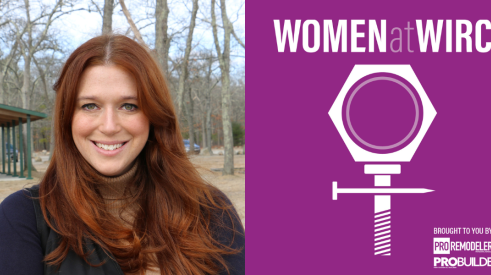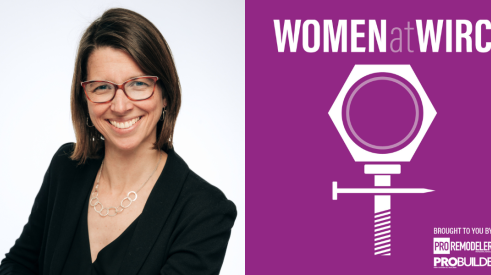In today’s remodeling market, establishing client relationships and maintaining them over the long-term is a difficult, yet attainable goal. Professional Remodeler’s Tom Swartz talked to remodelers Bill Owens and Ralph Cataldo about how they are keeping customers for life.
This month featuring:

Bill Owens, President
Owens Construction, Columbus, Ohio
Owens Construction has been in business for more than 30 years. The full-service design/build remodeling firm specializes in larger projects such as additions and whole-house remodels. Besides Owens, the firm has four full-time employees.

Ralph Cataldo, President and CEO
Cataldo Custom Builders Inc., East Falmouth, Mass.
Cataldo is a homebuilding and remodeling firm that does business ranging from large-scale remodeling projects to maintenance/repair. The firm has been in business for nearly 30 years and currently has seven full-time employees.
Tom Swartz: How important is a repeat customer for your business? What does a customer for life mean to you?
Ralph Cataldo: I believe that’s the single most important thing that will sustain a steady business. It all comes down to loyalty. To get loyalty you have to get trust; to get trust you have to build relationships. Once you get a real relationship going, you have to take advantage of every opportunity you can to proactively communicate on a consistent basis without overdoing it. Once you establish a client’s trust, you can eventually turn that trust into loyalty. We have multiple families where we have done 3 to 4 projects for the same family, whether it’s a remodeling project or a new home. We have one family where we have done four new homes, almost $10 million in volume, over the course of 10 years.
Because we were able to establish that loyalty and trust, they just keep calling us. They also go out of their way to tell their neighbors. If you do a really good job, these clients for life become “unpaid salespeople” who are out there selling for you. Before you know it, the neighbors are calling because you’ve given them [the previous client] a positive experience. There are multiple things you have to do to get to that loyalty point, and it takes a little while, but it’s relatively easy if you work hard from the first opportunity you get.
Swartz: How would you define your experience with a customer for life, and how important is the special repeat customer to your business?
Bill Owens: Way back in 1990, an auto salesman named Carl Sewell wrote a book, “Customers for Life.” It’s an interesting book from the perspective of the customer. What I find intriguing when I talk to folks involved in the [remodeling] business is that we tend to look at something way past the customer. We are not looking toward a one-time relationship at all, so we have prospects that are never considered anything other than clients if we convert them into a contract. The client, by the sheer nature of the definition, implies a professional relationship. But it’s deeply rooted in the idea that we are not doing a one-time project. It starts right in the office—how employees talk about and think about a project. We are looking to build a client base, not a customer base.
We are seeing transparency being more important than ever. People still want to work for a lump sum, a negotiated contract. But the client still wants to make sure the remodeler isn’t taking advantage of them. We are seeing a lot more upfront discussions on what is a fair overhead and what is a fair net-profit. Part of this is building a partnership, too.
Swartz: What marketing or advertising methods or techniques do you use to maintain a customer for life?
Owens: Right now we work a small market in Columbus, Ohio, specifically the northern suburbs. We had great success in building this bond and developing a presence in the community. Our yard and truck signs validate us, but it takes an active involvement in the community that gets us the most bang for the buck. We spend a lot of time with volunteer organizations and with the chambers of commerce, and we stay involved with the schools.
Each year, 6 to 8 percent of our yearly volume goes toward marketing. I would say 70 percent, maybe three-quarters of the marketing budget, is oriented toward activities to keep us immersed in the marketplace.
We also get high rankings on Google based on client feedback that can be found on unpaid customer-feedback websites. We are in the news a lot locally, and we also show up high on Google rankings because of all the work I do teaching and presenting nationally.
It is incredibly important that you have a presence on the Internet right now, and you have some consistency in all products, including the website that is going to reinforce your company’s message. The whole idea is to be in the marketplace. People want to do business with a company that has some stability and history.
Cataldo: I don’t spend much on advertising because I don’t think it’s worth it. One of the things I believe is that people want to do business with people they like. The person who answers the phone is the director of first impressions.
We know exactly what our break-even point is 12 months in advance based on strategic planning meetings. Our clients for life cannot support that number, so we have a certain amount of revenue dollars every year that we have to make up.
Eventually, if we continue our business ways, we should have close to 100 percent referral rate, which we don’t have now. Price is still a very big factor; it’s not as big as it was in 2008 and 2009 when people simply went for the low bid all the time. Now, it’s second lowest or third lowest because people are smarter. They’ve made mistakes going with low bidders who couldn’t finish a job and ruined the investment. I also believe the economy is better and buyer confidence is much higher, which helps all of us.
We have a resume that’s very strong and highlights all of our strengths. We also tell the client that we have no debt, we hire local people, and we don’t badmouth the competition. We let our resume speak for itself and our testimonials are key. We tell a potential client, “Don’t listen to me.” I encourage a potential client to contact our current clients and ask them any question they want about our business. That’s how strongly we feel about our team.
Swartz: In this changing market, how has technology changed how you’ve communicated with customers? Do you use social media? What does or doesn’t work in terms of social media to communicate with the customer for life?
Cataldo: Social media right now, in our generation, is a waste of time. Facebook is effective here and there. There is a good article in the October issue of Professional Builder (www.housingzone.com/social-media-critical-marketing-new-homes) that describes effectiveness of the different social media programs. I think websites and email are the most effective; especially, emails that include a number of photographs. Also, we communicate with our clients every week through a private website they can access with a username and password in order to see the progress of their project, no matter where they are in the country or the world. It’s been a very successful project for us, it costs nothing, and it works great.
There is also construction management software out there now that everyone can use to communicate as a common ground. Everyone can go the same website and pick up plans, view copies of change orders, see project photos, or read meeting minutes. All the content is out there. I think the construction management software could be important, websites are important, and finally, email and photographs are key.
Owens: Ralph hit the nail on the head. The older remodeler such as myself, the folks who have an established company, we’ve tried social media. We’ve dabbled a little bit with Facebook, but not to really any success at all.
I find the constant engagement provided by technology—the 24/7 connection—to be conflicting at times. Unless you are bold enough not to drag the telephone everywhere, you would never be off the hook. There are times when it’s important to leave the phone alone.
On the flipside, I love that aspect of technology because it does allow us to be engaged at all times. The cell phone, texts, and email all give a remodeler the ability to work very, very hard on individual projects. The work can also be done from a distance these days. I believe there is a tremendous opportunity in leveraging technology when staying connected with clients.
In the Digital Age, we are also seeing folks shopping using a virtual showroom. We are seeing the influence our website may have on a client in regard to decision or commitment to a project. The clients are also using technology to file financial performance forms, get qualification letters, and even close on the financing portion leg of the remodeling project.
A negative is that we are seeing a much more savvy, intelligent consumer. That can put a remodeler at odds if the remodeler does not know their product lines really well. We once had client tell us about how a window performs because they accessed the information from the manufacturer’s website.
Swartz: Who is involved in this process in trying to keep a customer for life? Do customers for life ask for any specific requests, such as a specific project manager?
Owens: We have a very loyal following, but it’s only because people enjoy working with our company. On the flip side, we closely watch our job costs and how much time we spend with the “care and feeding” of a client. That is a quantifiable number, and we absolutely will go in and assign a number for that “care and feeding.” It’s actually a line item when we talk about project management. That personal attention is how we satisfy the unique client.
As for the second question, a lot of it is consistency. We don’t shop the trades. A big component is that we have consistency in our trade contractors and consistency in our suppliers. We know what to expect from them, we know what their hot buttons are, and we know what it takes to keep the subcontractors happy.
Some want to get paid as soon as the job is done. In comparison, other subs want to have three weeks of prior knowledge that the job is hitting schedule, and they want to be called almost every day prior to the start just so they know what’s going on with the project.
Cataldo: If you start with hiring the right people who share consistent values, not only will you get the consistency in the office, the field, and the customer service message, you will get all sorts of extra effort out of your employees. Having people who are nice and getting feedback from clients are immeasurable. This has resulted in our staff even getting bonuses from our clients for life.
Over half a dozen times, my field staff and office staff have been given gift certificates and other gifts as appreciation for everything they’ve done to make the customer’s project a pleasurable experience. I’ve even had subcontractors of mine who share the same consistent moral and ethical values that we do—they’ve even gotten bonuses from the clients.
It starts from the first phone call, and everyone has to be on the same page. One of the key things is to get all of your employees to act the same way, and then get the best subcontractors for the least amount of money.
You have to get the “A” player for a “B-minus” price. We’ve been able to do that because we talk to the subs, negotiate with them, and tell everything they need to know. So, they can get into the jobsite, do their work, and make the profit they estimated. The bonus is that they get paid the same week if their invoice is submitted on time and our project manager signs off that the work is done in the appropriate manner and quality. That alone attracts the best people who will give the best effort on the jobsite.
Swartz: What would your advice be when it comes the topic of, “Do I need and how do I keep customers for life?”
Owens: I think it’s important to understand who your clients are, and who your clients for life potentially could be.
Remodelers should know when to say “no” and know when to get away from a client. It could be at the job development stage or at the contract stage. It’s taken me a fair number of years to understand that not everybody is going to be a client and not everybody is certainly going to be a client for life.
A lot can be said by building a stable group of clients for life but also you have to be enough of a professional to realize that it’s OK to fire a client for life.
Cataldo: There are two things: key items to remember, and how to jump-start your business.
A key item to remember is that service is more important than everything—communicate, communicate, and communicate. Do it quickly, professionally, and passionately. Then, I would say to people that your competition can only copy what you do, but they cannot copy who you are. They cannot copy the personalities of your company; there is no way they can do it. You have to build the relationship, earn their trust, and once you get their trust you get their loyalty. Once you get their loyalty, you know you’ve made it.
Also, you cannot underestimate the power of attitude. You have to have an energetic, upbeat attitude at all times. You can’t look at the clock; you have to do what you say you are going to do every time, and then some.
You have to take advantage of one opportunity at a time. You need the mind set that it’s your first job, and it’s your only job. You have to make the client feel like they are special and they are the only one. Do everything that you possibly can to satisfy that client. It’s also important to build your resume through high-quality photos and testimonials. The best time to get a testimonial is to catch the client when their emotions are high.
Always build on the competitive advantage. Being involved in the NAHB is key. Get professional advice and don’t be afraid to pay for that advice. Don’t ever take on too much work and complete your projects on time. Tell the truth and be transparent because people buy emotion. If you connect with them and earn their trust, you are going to do business with them for a long time. PR
In today’s remodeling market, establishing client relationships and maintaining them over the long-term is a difficult, yet attainable goal. Professional Remodeler’s Tom Swartz talked to remodelers Bill Owens and Ralph Cataldo about how they are keeping customers for life.
Add new comment
Related Stories
How to Create a World-Class Remodeling Team
Great remodeling companies position themselves for the future with the right players
Everyone Should Have a Number: KPIs for Your Design Build Team
Measuring key performance indicators guides your team to success while creating accountability and ownership
How to Revamp Your Pre-Construction Process
Experiencing too much slippage and delays? See how Bridget Bacon of Red House Design Build solved these issues by improving the remodeler's pre-construction process
How This Remodeler Revamped Their Pre-Construction Process
Bridget Bacon of Red House Design Build outlines how she helped transform the pre-construction process for improved finances and morale
Building A Small Projects Division from the Ground Up
Through hard work and careful strategy, Harth Home Services has seen big growth
A Mindset of Serving Others
A research study shows surprising results about what makes us take ownership of our work.
3 Keys to Successful Team Management
On this episode of Women at WIRC, hear Laura Burnes delve into her approach to leadership and project management, in addition to sharing insights into Adams + Beasley Associates' winning culture.
4 Steps to Prep Your Business for Contraction
How a remodeling company plans ahead for the worst of times (and the best of times)
Helping Remodelers 'Get Their House In Order'
From remodeler to NARI executive to industry consultant, Diane Welhouse uses her expertise to help business owners












